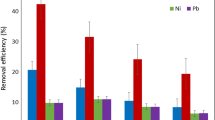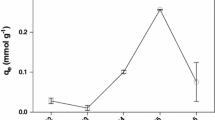Abstract
Biomass of cyanobacterial bloom from Lake Dianchi was used as a biosorbent for copper removal from aqueous solution. The maximum capacity was found at conditions of pH 4, initial concentration of copper was 10 mg/l and initial dose of biomass was 1.0 g/l. HNO3 demonstrated the highest desorption efficiency compared with HCl, EDTA, and citric acid. Physical adsorption was assumed not to be the dominant mechanism of biosorption as revealed by scanning electron microscopy and surface area measurement of the biomass. Infrared ray spectra analysis of the biomass suggested that ion-exchange is the principal mechanism for biosorption. Considering the advantages—low cost, easy to collect, and huge in quantity—the Microcystis bloom biomass could be used as a sorbent for copper and other heavy metals removal.






Similar content being viewed by others
References
Ahuja P, Gupta R, Saxena RK (1999) Sorption and desorption of cobalt by Oscillatoria anguistissima. Curr Microbiol 39:49–52
Chen J-Z, Tao X-C, Xu J, Zhang T, Liu Z-L (2005) Biosorption of lead, cadmium and mercury by immobilized Microcystis aeruginosa in a column. Process Biochem 40:3675–3679
Chojnacka K, Chojnacki A, Go’recka H (2005) Biosorption of Cr3+, Cd2+ and Cu2+ ions by blue-green algae Spirulina sp: kinetics, equilibrium and the mechanism of the process. Chemosphere 59:75–84
Crist DR, Martin JR, Guptill PW, Eslinger J, Crist DR (1990) Interactions of metals and protons with algae. Environ Sci Technol 24:337–341
De Philippis R, Paperi R, Sili C, Vincenzini M (2003) Assessment of the metal removal capability of two capsulated cyanobacteria, Cyanospira capsulata and Nostoc PCC7936. J Appl Phycol 15:155–161
Esposito A, Pagnanelli F, Lodi A, Solisio C, Veglio` F (2001) Biosorption of heavy metals by Sphaerotilus natans: an equilibrium study at different pH and tobacco dust biomass concentrations. Hydrometallurgy 60:129–141
Fourest E, Roux J (1992) Heavy metals biosorption by fungal mycelial by-product: mechanisms and influence of pH. Appl Microbiol Biotechnol 37:399–403
Gong R, Ding Y, Liu H, Chen Q, Liu Z (2005) Lead biosorption and desorption by intact and pretreated spirulina maxima biomass. Chemosphere 58:125–130
Huang JP, Huang CP, Morehart AL (1990) The removal of Cu(II) from dilute aqueous solutions by Saccharomyces cerevisiae. Water Res 24:433–499
Li P-F, Mao Z-Y, Rao X-J, Wang X-M, Min M-Z, Qiu L-W, Liu Z-L (2004) Biosorption of uranium by lake-harvested biomass from a cyanobacterium bloom. Bioresource Technol 94:193–195
Paperi R, Micheletti E, De Philippis R (2006) Optimization of copper sorbing-desorbing cycles with confined cultures of the exopolysaccharide-producing cyanobacterium Cyanospira capsulate. J Appl Microbiol 101:1351–1356
Pradhan S, Rai LC (2000) Optimization of flow rate, initial metal ion concentration and biomass density for maximum removal of Cu2+ by immobilized Microcystis. World J Microbiol Biotechnol 16:579–584
Pradhan S, Singh S, Rai LC (2007) Characterization of various functional groups present in the capsule of Microcystis and study of their role in biosorption of Fe, Ni and Cr. Bioresource Technol 98:595–601
Rinta-Kanto J, Ouellette A, Boyer G, Twiss MR, Bridgeman TB, Wilhelm SW (2003) Quantification of Toxic Microcystis spp. during the 2003 and 2004 Blooms in Western Lake Erie using quantitative real-time PCR. Environ Sci Technol 39:4198–4205
Sheng PX, Wee KH, Ting YP, Chen JP (2008) Biosorption of copper by immobilized marine algal biomass. Chem Eng J 136:156–163
Tunali S, Kiran I, Akar T (2005) Chromium(VI) biosorption characteristics of Neurospora crassa fungal biomass. Miner Eng 18:681–689
Utgikar V, Chen B-Y, Tabak HH, Bishop DF, Govind R (2000) Treatment of acidmine drainage, I: equilibrium biosorption of zinc and copper on non-viable activated sludge. Int Biodeterior Biodegrad 46:19–28
Vilar VJP, Botelho CMS, Boaventura RAR (2007) Methylene blue adsorption by algal biomass based materials: Biosorbents characterization and process behaviour. J Hazard Mater 147:120–132
Volesky B (2003) Biosorption process simulation tools. Hydrometallurgy 71:179–190
Wu X, Xiao B, Gong Y, Wang Z, Chen X, Li R (2008) Kinetic study of the 2-methyl-3-methoxy-4-phenylbutanoic acid produced by oxidation of microcystin in aqueous solutions. Environ Toxicol Chem 27:2019–2026
Acknowledgments
The study was supported jointly by the State Key Basic Research and Development Plan of China (2008CB418002) and the National Major Programs of Water Body Pollution Control and Remediation (2008ZX07103-004-01, 2008ZX07104-005-3).
Author information
Authors and Affiliations
Corresponding author
Additional information
An erratum to this article can be found at http://dx.doi.org/10.1007/s00284-010-9805-0
Rights and permissions
About this article
Cite this article
Wang, K., Liu, Y. & Li, D. Biosorption of Copper by Cyanobacterial Bloom-Derived Biomass Harvested from the Eutrophic Lake Dianchi in China. Curr Microbiol 61, 340–345 (2010). https://doi.org/10.1007/s00284-010-9617-2
Received:
Accepted:
Published:
Issue Date:
DOI: https://doi.org/10.1007/s00284-010-9617-2




